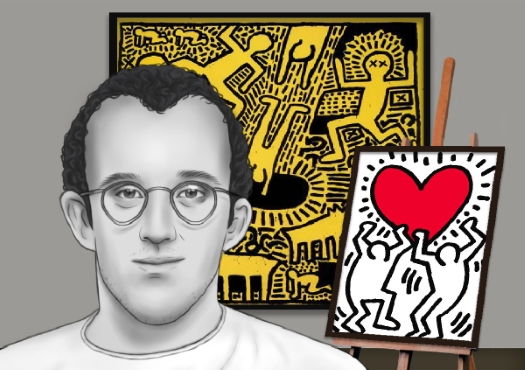Summary of Keith Haring
Keith Haring joined a long but sporadic lineage of 20th-century artists who brought elements of popular culture, "low art" and non-art elements into the formerly exclusive "high art" spaces of museums and galleries. He drew on the techniques and locales of street-based art such as graffiti and murals, employed bright and artificial colors, and kept imagery accessible in order to grab the eyes and minds of viewers and get them both to enjoy themselves and to engage with important concerns. Along with his artist contemporaries Jean-Michel Basquiat and Kenny Scharf, Haring opened the field of possibility for how seemingly simple and even cartoony elements by self-taught or less-schooled artists might be appreciated.
Accomplishments
- Haring's deceptively simple imagery and text provided poignant and cutting cultural commentary on issues including AIDS, drug addiction, illicit love, and apartheid. As both an artist and an activist he established that depicting serious issues could be fun or at least lively when communicated through highly cartoony images and fresh and vivid choices of colors.
- Haring's commitment to clean lines and simple images gave new life to figuration in painting, in contrast to the more abstract and conceptual approaches of the previous generation, and the more expressionistic gestural painting of his contemporaries.
- Haring provided proof of the possibilities of using public sites that were not usually dedicated to art to share artistic and political messages to multiple audiences. He lent street art credibility and legitimacy and took it into fine art galleries and museums, inspiring a new generation of street-to-gallery artists.
The Life of Keith Haring
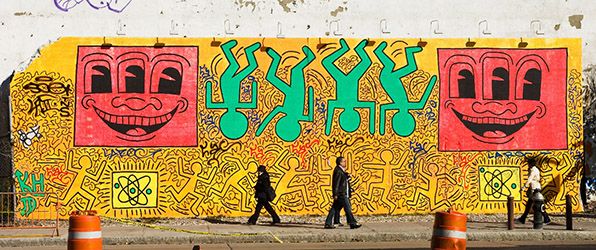
Saying, "The public has a right to art... Art is for everybody," Keith Haring created bold public art that packed a political punch. He intended, as he said, to "[break] down the barriers between high and low art."
Important Art by Keith Haring
Untitled
One of his early works, this radiant heart-love motif would show up in many paintings and drawings throughout the rest of his career. This innocent yet controversial image of two men in love is mild in comparison with Haring's later sexually explicit images., but the boldness of representing homosexual love at this point in time was already a significant statement and a marked achievement in the larger cultural realm. As his art career unfolded, and his confidence grew, it gave him the courage to generate more sexually explicit images of gay figures and scenes. In the above image, two people are depicted in love, with Haring's often-used lines of energy emphasizing this euphoric state as much as the kinetic movement of these figures' bodies in space. This image in many ways distills the optimistic attitude of Haring, who was, at heart, in many ways a Romantic, believing in humanity and the power of love.
Visually, the image is classic Haring in its flat, two-dimensional surface, cartoon-like simplicity and the use of vibrant, saturated colors. He often outlined his characters and scenes with thick black lines reminiscent of many earlier modern artists (such as Picasso), as well as from the Pop art movement (Warhol), in addition to Haring's contemporaries the 1980s New York City graffiti artists. Haring used vibrant lines in and around his subjects to convey energy, both positive and negative. Some attribute his adoption of this visual sign to the influence of Hip Hop music, where the visual imagery of dark lines was used to represent the impact of sound on listeners.
Acrylic on Vinyl - Brooklyn Museum Exhibit 2012
Untitled
A more graphic appreciation of the male form, this distorted rendering of a single large male figure gripping his own enormous, life-engendering penis suggests as much ambivalence as affirmation. The seemingly full-grown "offspring" of smaller figures spurt out of the phallic shape and fall precariously to earth, while the head of the main figure with its almost cubistically offset features is curled behind its own back to snap fiercely, mouth open, at that backside. The large size (114 x 157 inches) carries forward Haring's approach to the spectacular, immersive, larger-than-life outdoor mural into the wall-hung interior medium of drawing on paper. This sort of portrayal by Haring of not male nudity and sexuality helped usher in an era where previously taboo subjects could be brought forcefully to viewer's attention in both bold and nuanced ways. Haring's artistic productions called for radical new cultural possibilities and greatly expanded social understanding.
Acrylic On Paper
Free South Africa
Free South Africa was a political response to the conditions of apartheid that still existed in South Africa. The black figure is intentionally much larger than the white figure to express the irony of a post-colonial era where a white minority continued to suppress the majority native black population. The use of black lines makes for a sense of dynamic movement of the figures. Black outlines also express a heightened awareness of more psychologically charged elements - like the aura hovering around the restraining collar around the neck of the black figure.
Popular protest poster campaigns by artists such as Haring, using accessible images that lent themselves to circulation in posters, t-shirts and postcards. combined with world-wide public pressure from celebrities, politicians, and citizens, to raise awareness and influence change in South Africa. This wave of protests eventually led to Nelson Mandela - the lawyer/activist and 30-year prisoner of the South African Government - to be released from jail and elected president. Almost a decade later President Mandela ended apartheid for good in 1994.
Editions Poster
Untitled
Lesser known are Haring's works in sculpture and collage. Here at mid-career he created an elephant sculpture in papier mache painted over with acrylics. His signature black human cartoon persona was painted in different positions all over the white elephant. This may allude to humans dominating nature to the detriment of other species. The elephant may also have been purposely chosen based on the then anecdotal idea of its excellent memory - meaning one should never forget where you came from or who you are.. This black and white with red theme may have been a purely aesthetic choice based on the pleasing, simple yet powerful tri-color relationship. However, historically, the color white represents innocence, while the red horns and platform may indicate bloodshed, violence and/or passion. Among the largest of Haring's sculptures, the elephant is also unusually constructed of a different material than Haring's more typical use of aluminum, terra cotta or plaster for sculpture. It stands out as a rare example of a species that is divergent from his more usual humans, dogs, dolphins or serpents.
Acrylic on Papier Mache - Andy Warhol Museum
Crack is Wack
Crack is Wack is a public mural painted on a handball court in Harlem, New York City that can be seen from FDR Drive. It is a monochromatic piece in orange with Haring's signature black lines outlining the lettering and characters. This is one example of the many public paintings and murals Haring produced all over the world from 1982-89, but it is particularly notable for its originally illicit execution (though the City of New York quickly adopted it) and for the direct address to a social issue in a particular vulnerable locale.
The "Crack" in the mural refers to a cheaper form of cocaine that is smoked rather than snorted, and "Wack" is a slang term meaning "not good." A crack pipe at the bottom bears the central message set within a smoke cloud. Skull-death symbols loom large, as money burns away/is wasted as crackheads are consumed by personal demons and addiction. An ode to Picasso's Guernica (and suggestion of the symptoms akin to insanity that addiction to the drug might produce) can be seen in the animal with distorted eyes. The cross is a recurring religious symbol in Haring's paintings, representing a dogmatic and judgmental institution. Compositionally, Haring keeps the text-based message front and center, while at the same time integrating it in the larger group of surrounding images, partially through the dynamic dots that partially fill the letters of the message, resonating with the lines emanating from the figures on all sides. The crack epidemic lasted from the 1980s into the early 1990s in cities across the USA. African American urban communities were especially hard hit, perhaps underlying Haring's decision to do this anti-crack mural in Harlem.
Graffiti art and murals, along with Hip Hop music, arose during the 1980s in struggling, inner-city neighborhoods across the country. The USA was recovering from a long economic recession that had begun in the mid-1970s. Haring was a significant factor in spreading an awareness of murals worldwide. The medium of choice for most mural and graffiti artists was spray paint. Although toxic to inhale it did not stop street artists using it to express themselves on a number of issues, both local and global.
Public Mural in Harlem, NY
Rebel with Many Causes
Rebel with Many Causes is an example of Haring's recurring theme of 'hear no evil, see no evil, speak no evil' - a criticism of those who would avoid social issues, especially the AIDS crisis. The title of the piece suggests Haring's attitude as an artist and as an activist, as he incorporated both identities into his artwork. Openly gay when it was still considered taboo, he devoted himself to raising awareness of the AIDS crisis (e.g., through the movement ACT UP), when the federal government was slow to act. Many of his friends and associates died in the epidemic. He also produced art and campaigns to bring attention to blatant consumerism, environmental issues, and human rights.
Silkscreen on Paper - Guy Hepner Gallery NYC
Untitled
This piece is of a different character than Haring's usual stylistic choices. Though the density and maze-like design of the overall imagery filling out the canvas has a somewhat compulsive quality, in contrast to his usual Zen-like simplicity, there is a flow and beauty to his use of energetic lines. In them one can see influences of ancient world symbols such as Eastern Mandalas or Australian Aboriginal art, as well as contemporary graffiti art 'tags'. He often used the powerful color red in his work (though here, in this late work, it is somewhat muted in outlining the figures) as well as the then-new medium of paint markers to create smooth, thick lines. Haring always strived for an equilibrious balance of shapes in his electric line compositions, a sort of symmetrical quality that allows the eye to follow and flow in harmony with the image.
One can see in this work an interconnected world where even though the shapes and figures are similar in aspect, their individual postures nonetheless distinguish each of them as unique. The characters in this image all wield some type of tool in their hands, pointing to the artist's own use of tools to create works of art such as this painting itself. Throughout the composition there are illustrations of penetration that might be read in sexually Freudian terms - where the outside and inside of humans meet in an ongoing exploration of difference - as human sexuality is a frequent subject in Haring's works.
In this Untitled piece, however, the balanced composition seems as important formally as the symbolic representations of the content. It shows influences from European masters of the Modern era such as Miro, Klee, and late-period Matisse, all of whom accomplished notable achievements in styles that developed flat, richly colored shapes and patterns playing out across the surfaces of their canvases. This late example of Haring's work, rendered the year before he died, embodies a successful development of his clean-line figurative style melded to hints of abstraction in the figures' disposition and background color fields, as well as a more intricate and integrated composition than he had achieved in his earlier work.
Acrylic on Canvas - Property of Keith Haring Estate
Biography of Keith Haring
Childhood
Keith Haring was born on May 4, 1958 in Reading, Pennsylvania, but grew up in nearby Kutztown, Pennsylvania. He had three younger sisters. He discovered a love for drawing at an early age, learning basic cartooning skills from his father who drew comics as a hobby. Like many children of his generation he was an admirer of the popular animation of Disney, Dr. Seuss, and Looney Tunes.
Haring was raised in a religious family who attended the United Church of Christ, and as a teen he participated in the evangelical “Jesus Movement”. Later in his teen years, he travelled across the country by hitchhiking, making a few dollars by selling t-shirt that he made, promoting the band The Grateful Dead, as well as spreading anti-Nixon messages.
Early Training
After High School In 1976, Haring studied commercial art in the Ivy School of Professional Art in Pittsburgh. After only two semesters, and reading The Art Spirit (1923) by Robert Henri, which starts with the line “Art when really understood is the province of every human being,” and which promotes an interactive approach to creative production, he realized that he had no interest in becoming a commercial graphic artist and dropped out.
He remained temporarily in Pittsburgh and continued to study on his own, simultaneously working at the Pittsburgh Center for the Arts, where he was able to view the work of Jean Dubuffet, Jackson Pollock, and Mark Tobey. His other critical influences at this time were a 1977 Pierre Alechinsky retrospective, which inspired him to create large-scale works featuring text and figures, and a lecture by the sculptor Christo, who encouraged artists to involve the public in their work. In 1978 Haring had the good fortune to be invited for his first solo exhibition at the Pittsburgh Arts and Crafts Center when the Center's first choice artist cancelled. This gave him the confidence for the next big move in his fledgling art career - relocating to New York City.
Haring moved to New York’s Lower East Side in 1978, and enrolled in The School of Visual Arts (SVA), supporting himself by working as a busboy at the Danceteria nightclub. At school, he studied semiotics with conceptual artist Bill Beckley, and also dabbled in Performance, collage, Installation, and Video art. It was also at school that he befriended fellow artists Kenny Scharf and John Sex. He soon discovered an alternative art scene happening in the streets and subways led by Street and Graffiti artists. He became friends with fellow artist Jean-Michel Basquiat and photographer Tseng Kwong Chi.
Haring first started doing his own white chalk drawings in the subways on the readily available plain black empty background of advertising spaces. In his own words: "One day, riding the subway, I saw this empty black panel where an advertisement was supposed to go. I immediately realized that this was the perfect place to draw. I went back above ground to a card shop and bought a box of white chalk, went back down and did a drawing on it. It was perfect-soft black paper; chalk drew on it really easily."
These drawings about life, love, sex and death became conversation starters for New York's subway riders. As Haring told it: "I was always totally amazed that the people I would meet while I was doing them were really, really concerned with what they meant. The first thing anyone asked me, no matter how old, no matter who they were, was what does it mean?" He credited the immediate and continuing feedback of these encounters with helping him channel his stylistic choices. Between 1980 and 1985, he produced thousands of public drawings, developing his style of cartoon-like characters and symbols while also developing name recognition. Eventually, along with other artists, musicians and poets, he organized exhibitions at clubs, restaurants, and even in illegally appropriated buildings or "squats," which were common in the New York City of the early 1980s. Two spaces in particular - The Mudd Club and Club 57 - became "go-to" hot spots for aspiring, young, creative individuals.
At the age of only 20, Haring already had strong opinions about the art world, as shown in the following quote from his journal: "Art in 1978 has seen numerous attempts at classifying or labeling and then exploiting an idea until the idea itself is lost in the process." Later in the same journal entry he stated the idealist notion that "Art is life and life is art".
Mature Period
Between 1978 to 1982 Haring established himself as a respected "rebel" artist of the street and alternative indoor spaces, outside the elite New York art world. Eventually, he accepted representation from Tony Shafrazi and in 1982 made his high visibility fine art debut with a popular and highly acclaimed one-man exhibition at Shafrazi's Soho gallery. Over the next few years he participated in notable international exhibitions such as Documenta 7 in Kassel, the Sao Paulo Biennial, and the Whitney Biennial in New York.
Throughout the 1980s he produced dozens of murals and public works all over the world, including in Europe, South America, and Australia. Through his travels, he saw the art of ancient cultures up-close, such as the Maya of Central America, Bahia-Brazil's peoples of mixed African and native descent, and the Aboriginal people of Australia, all of which had a lasting influence on his artwork. He also created a mural for the 100th anniversary of the Statue of Liberty in 1986, on which he worked with 900 children. The following year he created a mural for Necker Children's Hospital in Paris, France, and a mural on the western side of the Berlin Wall (three years before it fell.) He also made lucrative commercial deals developing watch designs for Swatch and an advertising campaign for Absolut Vodka. He even painted bodies, including celebrities such as the iconic 1980's musician and performing artist Grace Jones. Much of his art was now politically charged such as the campaign to raise awareness about AIDS and South African Apartheid.
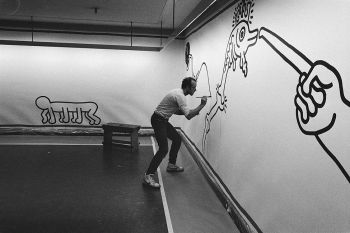
It was during this period that he developed a friendship with the famous Pop artist Andy Warhol. As with Basquiat, this relationship added to Haring's prestige and to the gradual, grudging acceptance of his work by the elite fine art establishment. American museum curators were still unsure about Haring's place in the canon of contemporary artists. This slow acknowledgement was similar to an earlier era when forward-looking European museums had acquired some of what became the most significant American modern artists of the 1950s and 1960s before the more conservative American museums accepted them into their prestigious institutions. To this day the biggest American museums such as the Museum of Modern Art in New York and the Art Institute of Chicago have only acquired a couple of Haring's lesser drawings, and other museums such as The Metropolitan Museum of Art in New York and Los Angeles County Museum of Art have none at all.

In 1986 Haring opened Pop Shop, his own art merchandise store in downtown Manhattan. He decorated the interior and his many black and white style doodles filled every corner of the retail space. The merchandise was meant to be popular and affordable, and T-shirts, toys, posters, buttons and magnets bore his images. Pop Shop opened the door for later experiments and crossovers to mass-scale or low-cost retail items from the hands or minds of celebrated "fine" artists such as Murakami, Koons, and even Banksy.
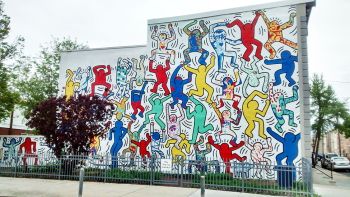
In a sad, ironic twist of fate, at the peak of his career Haring, who, throughout the 1980s had used his artwork to advocate for AIDS awareness, was diagnosed with AIDS in 1988. In 1989, he established the Keith Haring Foundation to provide funding and images to AIDS organizations, and allocate resources towards finding a cure for the devastating disease. He was prolific in creating artwork right up to his death but died in 1990 of AIDS-related complications at only 31 years old.
The Legacy of Keith Haring
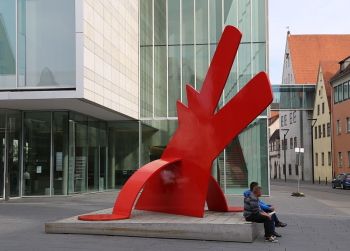
Many understand the overall ethos of street art as a rebellion against the status quo. For Haring this included the elitist fine art world itself. Though technically untrained rural folk art had found a niche, urban street art was only widely recognized after the 1980s commercial success of Haring and others such as Basquiat. Haring's success lent credibility and legitimacy to Street Art by proving it worthy of exhibition in fine art galleries and museums. As one very powerful example, Haring's didactic, subversive and cartoon-like art opened up the path for underground cartoonist Matt Groening's extremely successful Simpsons franchise (which included the longest running television show in American history, among other media that Groening's characters and images appeared in), a satire on the modern nuclear family and American values.
In the early-21st century murals and urban graffiti art are now a worldwide phenomenon, with periodicals and websites dedicated to them as art forms. Successful street artists from the early 1980s paved the way for future street-to-gallery artists such as Shepard Fairey, Banksy, and Swoon. These artists were and are still considered rebels, at times risking arrest and/or censorship to display their often politically charged art in both public and private spaces. By choosing this contrarian path they have in many cases ultimately been able to negotiate better terms for the exhibition and compensation of their work within the usually more closed, elitist circles of the fine art world.
Influences and Connections

-
![Pablo Picasso]() Pablo Picasso
Pablo Picasso -
![Joan Miró]() Joan Miró
Joan Miró -
![Andy Warhol]() Andy Warhol
Andy Warhol ![Pierre Alechinsky]() Pierre Alechinsky
Pierre Alechinsky
-
![Kenny Scharf]() Kenny Scharf
Kenny Scharf -
![Shepard Fairey]() Shepard Fairey
Shepard Fairey -
![Banksy]() Banksy
Banksy ![Matt Groening]() Matt Groening
Matt Groening![Swoon]() Swoon
Swoon
-
![Kenny Scharf]() Kenny Scharf
Kenny Scharf ![Jeffrey Deitch]() Jeffrey Deitch
Jeffrey Deitch
-
![Street and Graffiti Art]() Street and Graffiti Art
Street and Graffiti Art ![Neo Pop Art]() Neo Pop Art
Neo Pop Art
Useful Resources on Keith Haring
- Keith HaringOur PickBy Jeffrey Deitch
- Art Is Life: The Life of Artist Keith HaringBy Tami Lewis Brown and Keith Negley
- Keith Haring (Lives of the Artists)Our PickBy Simon Doonan
- Keith Haring: The Boy Who Just Kept DrawingBy Kay A. Haring
- Drawing on Walls: A Story of Keith HaringBy Matthew Burgess
- Keith Haring: The Authorized BiographyOur PickBy John Gruen
- Keith HaringOur PickBy Bruce D. Kurtz, David Galloway, Barry Blinderman, and Germano Celant
- Keith HaringBy Elizabeth Sussman
- Haring (Basic Art Series 2.0)Our PickBy Alexandra Kolossa
- Keith Haring's Line: Race and the Performance of DesireOur PickBy Ricardo Montez
- Keith Haring: The Political LineOur PickBy Dieter Buchhart, Julian Cox, Robert Farris Thompson, and Julian Myers-Szupinska
- Keith Haring: 1978-1982Our PickBy Gerald Matt and Raphaela Platow
- Art and Merchandise in Keith Haring’s Pop Shop (Routledge Advances in Art and Visual Studies)By Amy Raffel
- Keith Haring: Heaven and HellBy Ralph Melcher, Andreas Schalhorn, David Galloway, and Gotz Adriani
 Ask The Art Story AI
Ask The Art Story AI